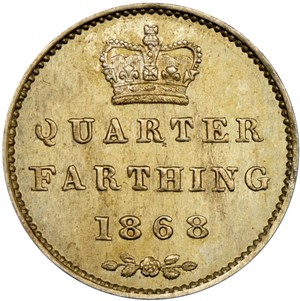British coins: the farthing
A farthing was an old British coin in the pounds, shillings and pence system. For most of its history it was the smallest value British coin.
A farthing had a value of one quarter of an old penny, or ¼d.
Where does the name 'farthing' come from?
The name farthing is derived from an old Anglo-Saxon word 'feorthing'. It means fourth part. [1]
The original farthings were made by cutting an Anglo-Saxon silver penny into four equal parts. The pennies were marked with a cross which made division easy. [1]
Since coins had their value by weight of silver this made sense.
When were the first farthings minted?
The first farthings were minted in the reign of Edward I (1272-1307).
What was a farthing made from?
The first farthings were minted in silver. Copper farthings were first minted in the reign of James I (1603-25).
In 1860 bronze became the metal used for pennies, halfpennies and farthings. The farthings from 1860 remained in circulation until 1961.
In Queen Victoria's reign shiny bronze farthings were similar in size and weight to gold half sovereigns. Some people were fooled and took a farthing for a half sovereign. A farthing was worth 960th of a pound. Given a Victorian pound had a value of around £80 in today' money it was quite a loss.
So the Royal Mint coloured some Victorian farthings black to guard against this.
The farthing bird

Image by Kev Chapman, licenced under Attribution 2.0 Generic (CC BY 2.0)
Victorian farthings had the same Britannia design as the penny and halfpenny. In 1937, the Royal Mint introduced new designs for both. The halfpenny had a picture of Sir Francis Drake's flagship, the Golden Hind. The farthing had a picture of a wren. The wren was Britain's smallest bird.
For children born in that era, the wren was known as the 'farthing bird'.
What could you buy with a farthing?
A farthing was a very low value coin. In 1960 it was worth about 1-2p in today's money.
A farthing had its uses, but it was becoming increasingly useless by the 1950s. Bus conductors refused to accept farthings, because customers would not accept them as change. Shopkeepers persisted in charging prices that ended with 11 pence and 3 farthings; the 1950s' equivalent of 99p. Some refused to take the farthing and preferred to put in a charity box.
Leaving a farthing tip
In 1950s Britain it was not acceptable not to tip a waiter or waitress. But what if you were not happy with the service?
The answer to one customer was to tip, but to tip a farthing. A farthing one quarter of an old penny was worth 1.5p in today's money. Quite an insult. Derisory doesn't cover it. [2]
A farthing as damages
British Law Courts also used the farthing to deliver an insult.
In February 1936 Sir Oswald Mosley, leader of the British Union of Fascists, took a court action against John Marchbank, leader of the National Union of Railwaymen for slander.
According to Mosley, Marchbank had said that Mosley had ordered British Union of Fascists' members to infiltrate the military. They were to find out how many officers could be persuaded to side with the fascists.
Marchbank also spoke of the fascists being a paramilitary organisation armed with clubs, knives and razor blades, ready to overthrow the government. In court Marchbank denied speaking the words alleged by Mosley and claimed fair comment as his defence. [3]
The jury found for Mosley, but there was a sting. In their view the action should never have been brought and that it was as close to fair comment as made no difference. They awarded Mosley one farthing in damages.
The last farthings
The Royal Mint issued the last farthings in 1956. In 1960 the inevitable happened and the farthing ceased to be legal tender. A sign of its uselessness was the condition of farthings cashed in 1960. They were almost perfect with no signs of wear. Even so a few remembered the farthing with nostalgia. As a child they bought a farthing's worth of sherbet with liquorice a stick, or a farthing bag of gob stoppers or bullseyes. [3]
Were there coins worth less than a farthing?

Yes, in Queen Victoria's reign there were half-farthings and quarter-farthings. They were intended to be used in Ceylon (today Sri Lanka). They were legal tender in the United Kingdom. You needed sixteen quarter farthings for one old penny.
Were there slang words for a farthing?
Yes, in Victorian England a farthing could be called a 'fadge', a 'fiddler', a 'gig' or a 'quartereen'.
Pennies, halfpennies and farthings were collectively called coppers.
Read more about old money slang.
The farthing in popular songs
The nursery rhyme 'Oranges and Lemons' has the phrase:
'You owe me five farthings say the bells of Saint Martin's.'
More recently in 1981 Tony Capstick's comedy song 'Captick Comes Home' lists a lot of things you could buy in the old days and still get change from a farthing!
References
[1] 'Money in Britain - A history of the Coins and Notes of the British Isles' by C R Josset, published in 1971 by David and Charles, page 47
[2] The Times 27 March 1956, page 11, issue 53490.
[3] The Times 8 February 1936, page 4, issue 47293.
[3] The Guardian 30 July 1960.


Comments